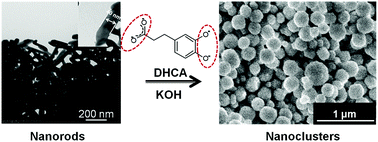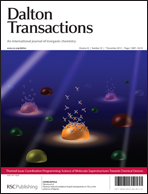Hydrothermal synthesis of inorganic–organic hybrid gadolinium hydroxide nanoclusters with controlled size and morphology†
Abstract
A series of gadolinium hydroxide [Gd(OH)3] nanoclusters having different morphologies was synthesized in the presence of 3,4-dihydroxy hydrocinnamic acid (DHCA), an organic modifier, under subcritical water conditions. These well-shaped Gd(OH)3 clusters are composed of many nanorods in a parallel orientation, rather than a disordered aggregation of nanorods, which are linked together by organic DHCA molecules. Here DHCA works as an inter-linker to form these cluster-like structures through coordination bonds. All samples were characterized by X-ray diffraction (XRD), scanning electron microscopy (SEM), transmission electron microscopy (TEM), Fourier transform infrared (FTIR) spectroscopy and SQUID magnetometry. We investigated the effect of the concentrations of DHCA and KOH on the size and morphology of the Gd(OH)3 clusters. Their possible formation mechanism is also briefly discussed.

- This article is part of the themed collection: Coordination Programming: Science of Molecular Superstructures Towards Chemical Devices

 Please wait while we load your content...
Please wait while we load your content...